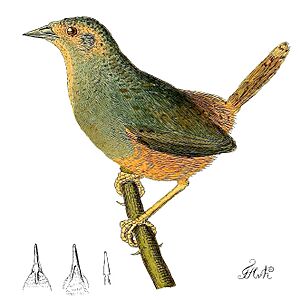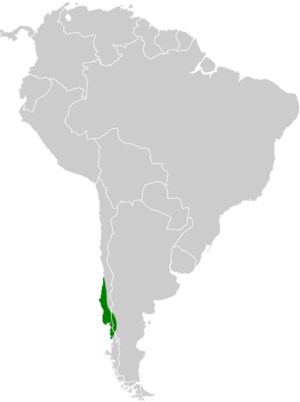Ochre-flanked tapaculo facts for kids
Quick facts for kids Ochre-flanked tapaculo |
|
|---|---|
 |
|
| Illustration by Heinrich von Kittlitz |
|
| Conservation status | |
| Scientific classification | |
| Genus: |
Eugralla
|
| Species: |
paradoxa
|
 |
|
The ochre-flanked tapaculo (Eugralla paradoxa) is a small, unique bird found in parts of Chile and Argentina. It belongs to the family Rhinocryptidae, which are known as tapaculos. These birds are often shy and live in dense forests.
Contents
About the Ochre-flanked Tapaculo
This bird is the only species in its group, called Eugralla. This means it's quite special! It doesn't have any different types or subspecies. For a while, scientists thought it belonged to another group, but they later confirmed its own unique place.
What Does it Look Like?
The ochre-flanked tapaculo is about 14.5 cm (5.7 in) long, which is roughly the length of a pen. Adult birds have dark gray feathers on their backs and lighter gray on their chests. Their belly and bottom are a clay-brown color, and their sides are a warm, tawny brown. Young tapaculos look a bit different; they have stripes of cinnamon or reddish-brown over dusky gray feathers. One interesting feature of this bird is its "Roman nose" facial shape, which is unusual for a tapaculo.
Where Does it Live?
You can find the ochre-flanked tapaculo all year round in south-central Chile and the western parts of Argentina. It lives from sea level up to about 900 m (3,000 ft) high, and maybe even higher! This bird prefers to live in thick bushes and bamboo patches within Nothofagus forests. It also likes older, grown-up forests.
Behavior and Habits
Feeding Habits
Ochre-flanked tapaculos usually look for food in pairs. They search on or very close to the ground, always staying hidden in dense plants. Scientists believe they mainly eat arthropods, which include insects and spiders.
Reproduction and Nests
These birds are known to "double brood," meaning they lay eggs twice in one season! They lay their first set of eggs in September and a second set in November. Their nest is quite big, shaped like a ball, and made of straw and grass. It has an entrance on the side. They usually build their nests about 1 to 2 m (3.3 to 6.6 ft) off the ground, but sometimes they can be as high as 7 m (23 ft). You might find their nests hidden in thick bushes, small trees, or even piles of branches.
Bird Calls and Songs
The song of the ochre-flanked tapaculo is a quick series of sharp "check" notes. You can listen to an example here: [1]. When a pair of these birds wants to stay in touch with each other, they make a softer "kek" call. Here's what that sounds like: [2].
Conservation Status
The IUCN (International Union for Conservation of Nature) has listed the ochre-flanked tapaculo as a species of "Least Concern." This means that, for now, it's not considered to be in immediate danger of disappearing. It lives across a fairly large area and is quite common in the southern parts of its range. There are even some protected areas in Chile where it lives safely. However, scientists don't know exactly how many of these birds there are, and they believe the population might be slowly getting smaller.


